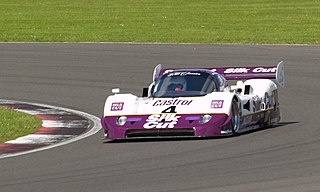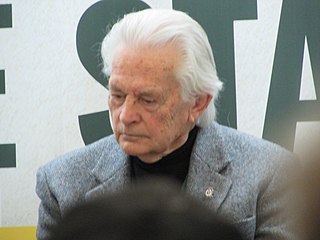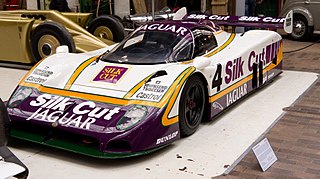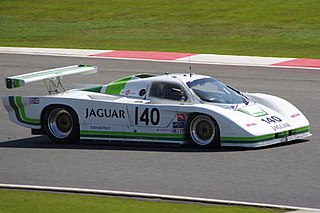
The Jaguar XJ-S is a luxury grand tourer manufactured and marketed by British car manufacturer Jaguar Cars from 1975 to 1996, in coupé, fixed-profile and full convertible bodystyles. There were three distinct iterations, with a final production total of 115,413 units over 20 years and seven months.

The Jaguar XJ220 is a two-seat sports car produced by British luxury car manufacturer Jaguar from 1992 until 1994, in collaboration with the specialist automotive and race engineering company Tom Walkinshaw Racing. The XJ220 recorded a top speed of 212.3 mph (341.7 km/h) during testing by Jaguar at the Nardo test track in Italy. This made it the fastest production car from 1992 to 1993. According to Jaguar, an XJ220 prototype managed a Nürburgring lap time of 7:46.36 in 1991 which was faster than any production car lap time before it.

The 24 Hours of Le Mans is an endurance-focused sports car race held annually near the town of Le Mans, France. It is widely considered to be one of the world's most prestigious races, and is one of the races—along with the Monaco Grand Prix and Indianapolis 500—that form the Triple Crown of Motorsport and is also one of the races alongside the 24 Hours of Daytona, and 12 Hours of Sebring that make up the informal Triple crown of endurance racing. Run since 1923, it is the oldest active endurance racing event in the world.

The Jaguar Sport XJR-15 is a two-seater sports car produced by JaguarSport, a subsidiary of Jaguar and Tom Walkinshaw Racing between 1990 and 1992. Only 50 were planned, each selling for £500,000.

The Sauber C9 is a Group C prototype racing car introduced in 1987 as a continuation of the partnership between Sauber as a constructor and Mercedes-Benz as an engine builder for the World Sportscar Championship. The C9 replaced the Sauber C8.
Tom Walkinshaw Racing (TWR) was a motor racing team and engineering firm founded in 1976, in Kidlington, near Oxford, England, by touring car racer Tom Walkinshaw.

The Jaguar XJR-9 is a sports-prototype race car built by Jaguar for both FIA Group C and IMSA Camel GTP racing, debuting at the 1988 24 Hours of Daytona.

The 1990 24 Hours of Le Mans was the 58th Grand Prix of Endurance, and took place on 16 and 17 June 1990.

The 1989 24 Hours of Le Mans was the 57th Grand Prix of Endurance, and took place on 10 and 11 June 1989.

The 1988 24 Hours of Le Mans was the 56th Grand Prix of Endurance, and took place on 11 and 12 June 1988. It was also the fifth round of the World Sports-Prototype Championship season.
Walter Thomas Frederick Hassan OBE, C.Eng., M.I. Mech.E. was a distinguished UK automotive engineer who took part in the design and development of three very successful engines: Jaguar XK, Coventry Climax and Jaguar V12, as well as the ERA racing car.

The Nissan R390 GT1 was a racing car built in Atsugi, Japan. It was designed primarily to gain a suitable racing entry in the 24 Hours of Le Mans in 1997 and 1998. It was built to race under the grand touring style rules, requiring a homologated road version to be built. Therefore, the R390 was built originally as road car, then a racing version of the car was developed afterwards. Only one R390 road car was ever built and is stored at Nissan's Zama facility, although one of the race cars was later modified for road use. The road car was claimed to be capable of attaining a top speed of 354 km/h (220 mph). However, this claim has never been proven.

The Jaguar XJR-14 is a sports-prototype racing car introduced for the 1991 World Sportscar Championship season. It was designed by Ross Brawn and John Piper, and was built and run by Tom Walkinshaw Racing (TWR), on behalf of Jaguar Cars.

The Mercedes-Benz C291 was a sports-prototype racing car introduced for the 1991 World Sportscar Championship season. It was Mercedes-Benz’ final car in the Group C category.

The Jaguar XJR sportscars were a series of race cars used by Jaguar-backed teams in both the World Sportscar Championship (WSC) Group C and the IMSA Camel GTP series between 1984 and 1993.

The Jaguar XJR-11 was a sports-prototype racing car introduced for the 1989 World Sports Prototype Championship, while its sister car the XJR-10 was introduced to compete in IMSA series races.

The Mulsanne Straight is the name used in English for a formerly 6 km (3.7 mi) long straight of the Circuit de la Sarthe around which the 24 Hours of Le Mans auto race takes place. Since 1990, the straight is interrupted by two chicanes, with the last section leading to a sharp corner near the village of Mulsanne. Before the chicanes were added, the Mulsanne Straight was the longest straight section of any race track in the world.

Tony Southgate is an English engineer and former racing car designer. He designed many successful cars, including Jaguar's Le Mans-winning XJR-9, and cars for almost every type of circuit racing. He was responsible for the chassis design of Ford's RS200 Group B rally car. Southgate was employed as chief designer or technical director for many Formula One teams for over twenty years. These teams included BRM, Shadow and Arrows. Southgate retired after producing the Audi R8C, which was a major influence in the Bentley Speed 8, which won Le Mans in 2003. He continues to be a regular visitor to current and historic race meetings.

The XJR-8 was a race car built by Jaguar for campaigning in the World Sportscar Championship and the 24 Hours of Le Mans as part of Group C. It was used during the 1987 season.

The Jaguar XJR-5 is a IMSA GTP sports prototype race car, designed, developed and built by Group 44 racing for Jaguar with the aim of competing, from 1982, in the IMSA GT Championship. Jaguar XJR-5s contested until 1985, before Jaguar replaced it with the Jaguar XJR-7.


















